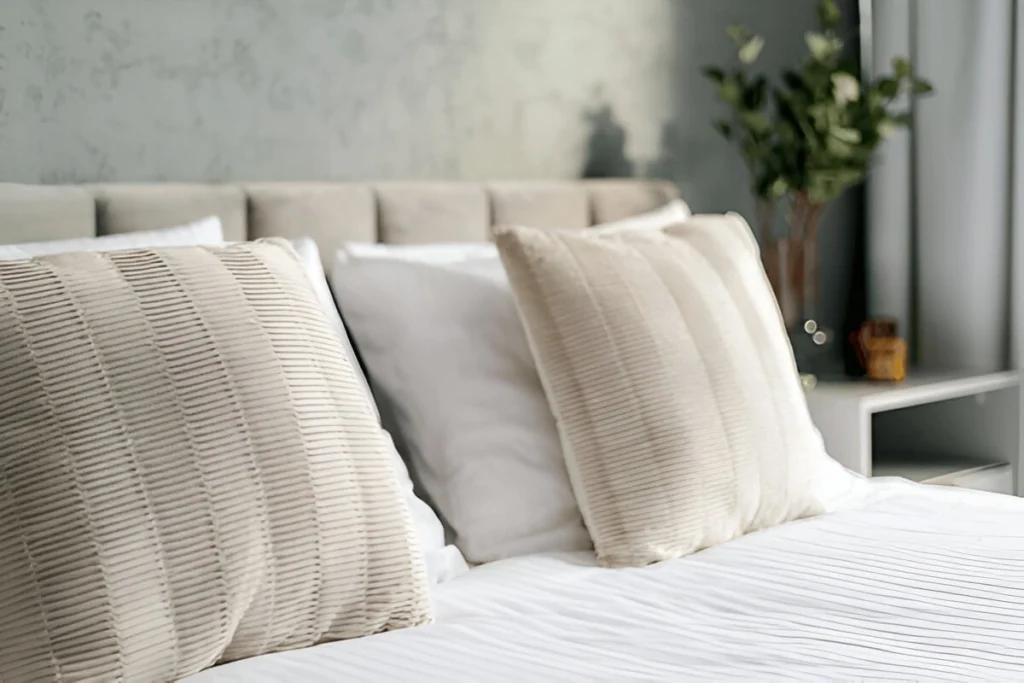Pillows serve as the backbone of our daily routines by offering relaxation during sleeping hours. Do you wonder who created sleeping pillows and how their development took place across history? Over centuries societies evolved their head support methods from early beginnings to today’s advanced cushion products. People originally used pillows for both real-world applications and signification yet professionals and high-end patrons enjoy various levels of their scientific and luxurious benefits today. The article examines Who Invented A Pillow?, the beginning points of pillows, and explains their development through official sources and expert advice about their value today.
Origins of the Pillow: Who Invented It?

The First Known Pillows
The earliest historical records show that people used pillows since ancient times. Pillows first appeared among the individuals of Ancient Mesopotamia in 7000 BC as stone construction. They served mainly as a defense against bugs by blocking their entry into sleeping persons’ ears and mouths. Pillows began as symbols of status since only the high-ranking people owned them in that period.
Ancient Egyptians and Chinese Pillows
Pillows in Ancient Egypt
During the ancient Egyptian period from 3000 BC to 1000 BC the nation placed pillows in tombs to defend the spirits of the deceased. People made pillows out of wood and stoneware to create religious designs that protected them from spiritual harm.
Role of Pillows in Chinese Culture
During the period from 1000 BC to 200 CE the ancient Chinese (ancient China) developed their pillow-making skills to produce pillows from jade porcelain and bamboo materials. People selected ceramic pillows due to their belief that they helped support mental clarity and guaranteed restful sleep. Modern sleeping pillows were not available because people used durable yet inflexible variants.
Greek and Roman Innovations: The Rise of Soft Pillows
The Shift to Comfort
During ancient times (ancient civilizations times) the Roman Empire and ancient Greece introduced more comfortable sleeping surfaces filled from feathers to straw to wool. Their pillows served the main purpose of feeling good rather than the older disruptive designs. Well-off Romans showed their social rank by resting on bed pillows stuffed with down and draped in fine silk. Society made a major historical transition by replacing hard pillow materials with softer alternatives.
The Middle Ages: Decline and Revival
The Rejection and Return of Pillows
In the medieval period, society looked down on pillows because they connected weakness in men. During the Renaissance era, everyone in Europe started using pillows at home again after their absence during the Middle Ages. During the Renaissance era homes introduced decorative throw pillows to their interior design.
Industrial Revolution and Mass Production

The Rise of Affordable Pillows
Pillow-making entered a new phase during the Industrial Revolution from 18th to 19th centuries. The manufacturing process made pillows available to everyone at reasonable prices. Textile advancements helped producers use softer materials like cotton and linen which made pillows more pleasant to use and within the reach of many people.
Modern Pillows: Science and Luxury Combined
The Impact of Science on Pillow Design
Pillow manufacturers now create their products through scientific processes. Specialized pillows based on orthopedic and ergonomic design work together to adjust spinal placement and enhance the overall sleep experience. When NASA first developed memory foam in the 1960s it brought scientific improvements to the pillow industry by supporting user pressure and temperature reactions.
Luxury Pillows: A Status Symbol
Luxury brands create better pillows using luxury materials like silk linings and high-count threads together with superior fillings like goose down. Wealthy customers choose Tempur-Pedic and Hästens pillows because these brands combine top-quality comfort with social standing for their sleep products.
Expert Opinions on Pillows and Sleep Quality

What Do Sleep Experts Say?
- Dr. Matthew Walker, Neuroscientist, and Sleep Expert: In his book Why We Sleep, he emphasizes the importance of a good pillow in improving sleep quality and cognitive function.
- Dr. Michael Breus, Sleep Specialist: He highlights the role of memory foam pillows in reducing neck pain and improving REM sleep cycles.
- Ergonomic Expert Lisa Artis: She states that the right pillow can significantly reduce headaches and posture-related issues.
- Mike Lindell, founder of MyPillow, advocates for customized pillows that cater to individual sleep needs, ensuring better comfort and support.
The Future of Pillows: Smart Sleep Technology

Innovations in Pillow Design
Technology research created smart pillows that watch rest patterns while monitoring health conditions plus delivering audio to help people sleep better. Moona and Eight Sleep brands use artificial intelligence to improve what users experience during sleep.
Ancient Pillows Vs. Modern Pillows
| Feature | Ancient Pillows | Modern Pillows | Cultural Significance |
|---|---|---|---|
| Material | Stone, wood, ceramic, jade, straw | Memory foam, cotton, down, polyester | Ancient pillows symbolized status, protection, and spirituality |
| Purpose | Protection from insects, spiritual significance | Comfort, spinal alignment, sleep improvement | Modern pillows are linked to wellness, luxury, and personalized sleep experiences |
| Softness | Hard and rigid | Soft, adjustable, and ergonomic | Shifted from rigid designs to plush, customizable options |
| Users | Mostly elite classes and royalty | Common among all social classes | Once reserved for the wealthy, now accessible to everyone |
| Design | Simple, decorative, symbolic carvings | Scientific, ergonomic, luxury-oriented | Decorative and spiritual carvings in the past vs. functional and aesthetic focus today |
| Technology | Handcrafted, limited innovation | AI-integrated, smart pillows, cooling gels | Ancient pillows reflected traditional craftsmanship; modern pillows incorporate science for comfort |
FAQs About Who Invented A Pillow

Q1. Who invented the first pillow?
The people of Mesopotamia first created pillows around 7000 BCE using stone materials. This pillow is also known as stone pillows.
Q2. Why were ancient pillows made of hard materials?
People in ancient times designed pillows mainly to shield their ears and mouths from insects at night using natural rocks and timber.
Q3. When did soft pillows become common?
Ancient Greeks and Roman societies introduced comfortable pillows made from feathers and wool during their time.
Q4. What materials are used in modern luxury pillows?
Luxury pillows today are made of top-end natural materials including silk, Egyptian cotton, and goose-down feathers. People use travel and body pillows nowadays to sleep more conveniently.
Q5. What materials are used in modern luxury pillows?
Memory foam pillows fit the head and neck perfectly to give better support and spine alignment while removing uncomfortable pressure areas.
Q6. Are ergonomic pillows worth it?
People who use ergonomic pillows decrease neck pain while feeling better because they get improved head-neck support through these products.
Q7. What are smart pillows?
Enhanced sleep technology in smart pillows assists with sleep quality management through multi-functional features.
Conclusion

Throughout history, humans have developed pillow designs starting with Ancient Chinese Pillows beginnings and ending with advanced sleep technology. People use pillows both for health relief and an experience of luxury which has made them necessary for sleep. Pillows continue improving through modern technology that gives users better rest with customized sleep support. Sleep science development will keep the pillow selection as a key part of reaching a refreshing and good night’s sleep.
- Who Invented a Pillow? Evolution and Significance of Pillows - February 24, 2025
- Rattan Sofa Halbrund Perfect For Luxury and Comfort - February 19, 2025
- Sweet Dreams Pillow A Luxurious Sleep Experienc - February 16, 2025
